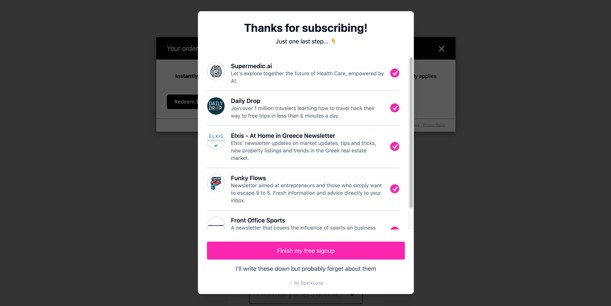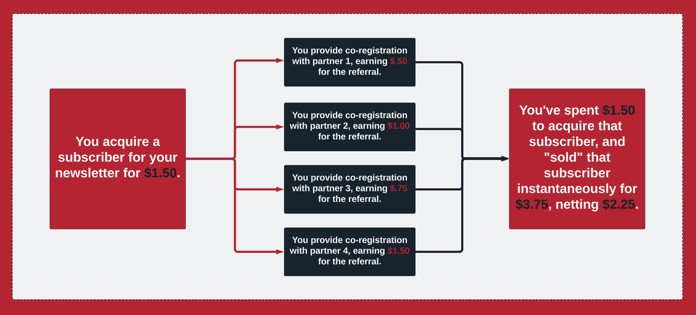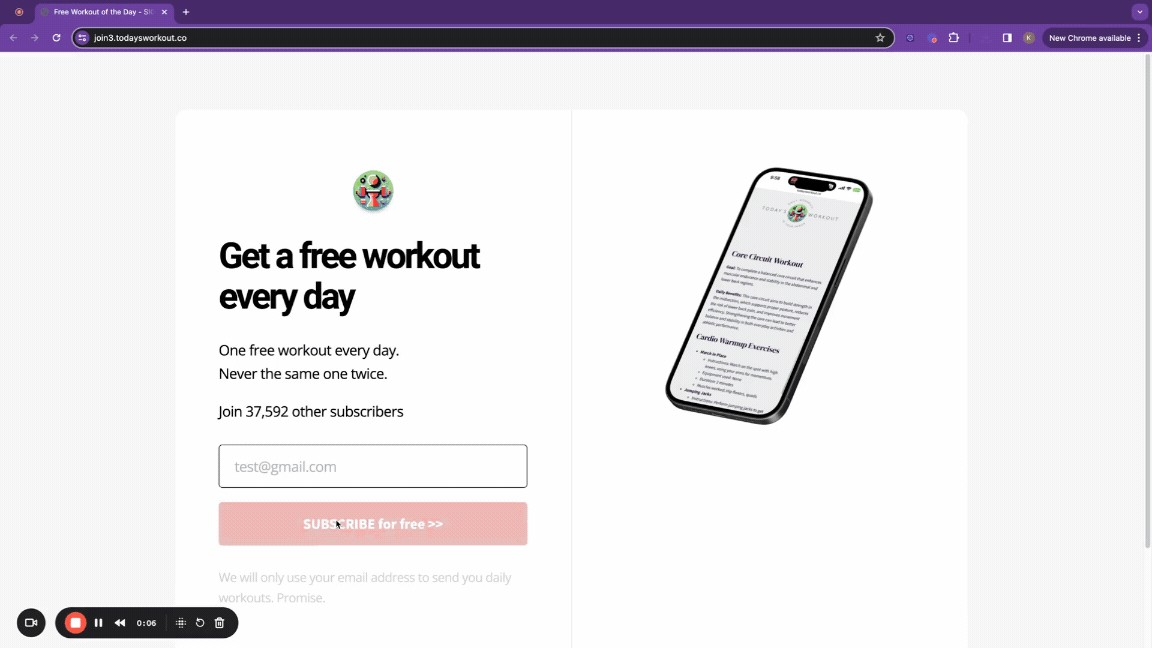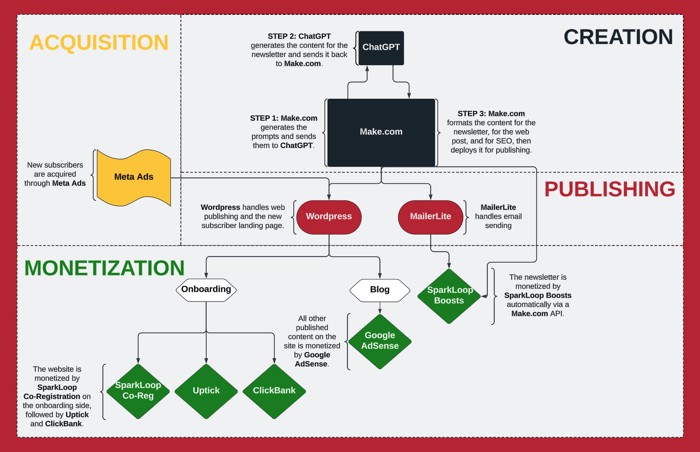Welcome to Trends, a weekly newsletter with the zestiest business trends and actionable insights for entrepreneurs.
So you’re cruising along on Instagram, and see an ad for a newsletter that grabs your attention.
You give the ad a click, and enter your email to subscribe.
That publisher has aced everything up until that point with:
- An enticing message on their ad
- Placed in front of you on the right platform
- A landing page that got you to convert
But after you click “subscribe”, something a little different happens…

SparkLoop’s co-registration widget. Tricky dicky.
This publisher (who you only know from the ad they served you moments ago) is recommending other newsletters.
All of the newsletters are pre-selected, and unless you read very carefully, you’re likely to hit the big pink box at the bottom of the screen and move on with your life.
But let’s look at the newsletters that were recommended:
- An AI healthcare newsletter 💊
- A travel deals newsletter ✈️
- A newsletter about the Greek real estate market 🇬🇷
- A newsletter for entrepreneurs 📈
- And a sports newsletter 🏈
Um. What.
Moments later, your inbox looks like this.
Here’s what’s happening:
👉 The newsletter you wanted to subscribe to is getting paid by every newsletter they’re recommending, so long as you meet some “engagement” criteria (more on that later).
👉 At a minimum, they’re off-setting the ad spend they used to acquire you, but they might be earning more from recommendations than they’re spending on ads —
Which makes them profitable before you ever even receive a newsletter from them.
This, ladies and gentlemen, is “audience arbitrage”.
And it’s either the best or the worst trend to ever grab the newsletter industry, depending on who you talk to…
Arbitrage Is What Now?
If you’re not a securities trader, you may not know what arbitrage means, so let’s break this down.
In the case of securities (where arbitrage is a formidable strategy) it means simultaneously buying a security and selling it at a higher price.

Don’t worry. We’ll explain. Source: Tenor
But this concept extends to other commodities as well.
For instance, Ebay and Amazon have made retail arbitrage incredibly popular over the last decade. Here’s how it works:
- People run around town, buying up name-brand shit at liquidation / clearance sales.
- Then they sell it on Amazon at market price for a profit.
According to Andy Craig, Amazon expert and founder of AdHabit, “You can make good money. It can be a good side-hustle. But it’s not really a business.”
Now, thanks to co-registration tools like SparkLoop and Beehiiv’s newsletter recommendation widgets, the same thing is happening with newsletters.
And audiences are the commodity.

Here's a visual aid to explain the process.
Does This Really Work?
Arthur Freydin, an e-comm growth expert and owner of Newsletter Blueprint, set out to do this with a totally automated newsletter — Today’s Workout.
Arthur uses a number of platforms, but his recipe boils down to:
- Acquisition: Meta Ads
- Monetization: SparkLoop (a newsletter referral platform)
- Automation: Make.com (a no-code workflow platform)
After clicking on one of Arthur’s Meta ads, subscribers are:
👉 Funneled to a Wordpress landing page.
👉 Monetized immediately upon signup with SparkLoop’s co-registration widget (this is the true audience arbitrage piece).
👉 And for good measure, they’re monetized three more times with offers by Uptick, ClickBank, and Amazon.

Holy mother of popups. Source: Today’s Workout onboarding flow.
But the true magic lies in how Arthur is able to send out an automated newsletter every day without touching a thing:
👉 Make.com generates a prompt for ChatGPT to write a “fitness workout of the day”.
👉 ChatGPT writes all of the content for that day’s post, and sends it back to Make.com.
👉 Make.com formats the content for a web post and an email newsletter, including SEO considerations.
👉 Then Make.com retrieves referral boosts (recommendations in the email for other newsletters) for placement in the email from SparkLoop via API so that day’s send can be monetized.
👉 Finally, Make.com automatically publishes the web version to Wordpress (which is monetized via Google AdSense), and sends the newsletter version out to subscribers using MailerLite (which is monetized by SparkLoop).
Here’s how the whole thing looks:

Holy moly. Well crafted. 👏
This entire thing took Arthur about a week to set up. He’s netting ~$1.2k per month (~70% margin) — and he reckons if he took some more time to hone it, he could increase earnings 3X or more.
So What’s The Catch?
While audience arbitrage using co-registration seems like a no-brainer for newsletter monetization and growth, it comes with substantial risks.
Risk #1: Your Brand
“Co-registration completely disregards the human experience,” announced Adam Ryan, former President of The Hustle, and co-founder of the community-centric media brand Workweek on stage at a recent conference…
…which was sponsored by SparkLoop. 😬
“Publications forget that their audiences are people.”
So if you’re trying to make a quick buck with a throwaway brand, it can work — as long as you keep your subscriber acquisition cost below your rate of monetization.
But if you’re trying to build trust with your audience, it’s probably not a good idea to group yourself in with a bunch of random newsletters chaotically crowding the inbox of your ideal subscriber (who you just spent time and money to strategically acquire).

Risk #2: Your Sender Health
While this is an issue for everyone, it especially impacts those who are using co-registration tools for growth as well as monetization.
When quick-moving or unassertive audiences accidentally sign up for six newsletters (when they only meant to sign up for one), they’re in for a heck of a surprise in their inbox.
And what happens when you start sending people a ton of unwanted emails?
Your sender health and deliverability goes to shit.
Which means you might start landing in spam with the subscribers who genuinely want to hear from you, or with new rules that Google and Yahoo recently implemented, you could get shut out of inboxes completely.
“Proceed with extreme caution when it comes to co-registration tools like SparkLoop,” says Tyler Cook, email deliverability expert and founder of Hypermedia Marketing.
Risk #3: Opaque Engagement Reporting
When you’re monetizing your newsletter with co-registration platforms like Beehiiv and SparkLoop, you only get paid for a successful referral when the subscriber meets the engagement criteria set by the newsletter you’re recommending.
But those metrics often get incorrectly reported at the individual level, and there are a number of ever-evolving ways email service providers are protecting receiver data (a whole ‘nother topic…).
So it’s kinda like trusting a blindfolded accountant to do your books. They might get some of it right, but there’s really no way to know.
And for those in growth mode? Get ready for hoards of unqualified subscribers.
So while it’s definitely the newsletter strategy du jour, audience arbitrage may not have what it takes to survive.

